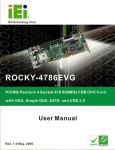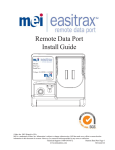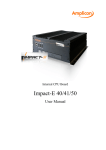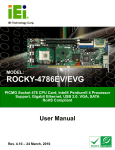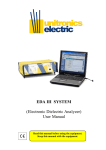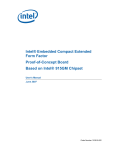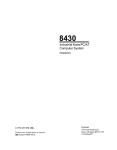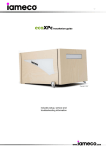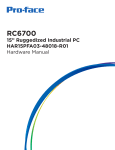Download 1510 with P4 Industrial PC Computer System User Manual
Transcript
1510 with P4 Industrial PC Computer System User Manual 2007 XYCOM AUTOMATION, LLC. Printed in the United States of America Revision Record Revision Description Date A B C D Manual Released Manual Updated for ROCKY-4786EVG Further additions and corrections Name change, correct where applicable with document 09/03 01/07 01/07 04/07 Part Number 143082 (D) Trademark Information Xycom and Xycom Automation are trademarks of Xycom Automation, L.L.C. Xycom Automation, L.L.C. now is referred to as Pro-face through a D.B.A. The Pro-face name and logo will replace the Xycom name and logo on all documents where possible. Pro-face is a trademark of Digital Electronics Corporation. Brand or product names are registered trademarks of their respective owners. Windows is a registered trademark of Microsoft Corp. in the United States and other countries. Copyright Information This document is copyrighted by Xycom Automation, L.L.C. (Xycom) and shall not be reproduced or copied without expressed written authorization from Xycom Automation, L.L.C. The information contained within this document is subject to change without notice. Pro-face does not guarantee the accuracy of the information. United States FCC Part 15, Subpart B, Class A EMI Compliance Statement: NOTE: This equipment has been tested and found to comply with the limits for a Class A digital device, pursuant to part 15 of the FCC Rules. These limits are designed to provide reasonable protection against harmful interference when the equipment is operated in a commercial environment. This equipment generates, uses, and can radiate radio frequency energy and, if not installed and used in accordance with the instruction manual, may cause harmful interference to radio communications. Operation of this equipment in a residential area is likely to cause harmful interference in which case the user will be required to correct the interference at his or her own expense. WARNING: This is a Class A product. In a domestic environment, this product may cause radio interference in which case the user may be required to take adequate measures. Electromagnetic Compatibility – WARNING for European Users: The connection of non-shielded equipment interface cables to this equipment will invalidate FCC EMI and European Union EMC compliance and may result in electromagnetic interference and/or susceptibility levels which are in violation of regulations which apply to the legal operation of this device. It is the responsibility of the system integrator and/or user to apply the following directions, which relate to installation and configuration: All interface cables must include shielded cables. Braid/foil type shields are recommended. Communication cable connectors must be metal, ideally zinc die-cast backshell types, and provide 360-degree protection about the interface wires. The cable shield braid must be terminated directly to the metal connector shell; ground drain wires alone are not adequate. Protective measures for power and interface cables as described within this manual must be applied. Do not leave cables connected to unused interfaces or disconnected at one end. Changes or modifications to this device not expressly approved by the manufacturer could void the user’s authority to operate the equipment. EMC compliance is, in part, a function of PCB design. Third party add-on AT/XT peripheral PCB assemblies installed within this apparatus may void EMC compliance. FCC/CE compliant PCB assemblies should always be used where possible. Pro-face can accept no responsibility for the EMC performance of this apparatus after system integrator or user installation of PCB assemblies not manufactured and/or expressly tested and approved for compliance by Pro-face. It is the responsibility of the system user to ensure that installation and operation of such devices does not void EMC compliance. i TABLE OF CONTENTS CHAPTER ONE – INTRODUCTION............................................................................................................................1 PRODUCT OVERVIEW ..................................................................................................................................................1 Standard Features ...............................................................................................................................................1 Optional Features ................................................................................................................................................2 UNPACKING THE SYSTEM .............................................................................................................................................2 QUICK START-UP ........................................................................................................................................................3 CHAPTER TWO – INSTALLATION ............................................................................................................................4 SYSTEM COMPONENTS ................................................................................................................................................4 Internal View ........................................................................................................................................................5 Front View............................................................................................................................................................6 Back View ............................................................................................................................................................7 PS/2 KEYBOARD AND MOUSE CONNECTOR ...................................................................................................................8 INSTALLING OPTIONS ...................................................................................................................................................8 Internal Hardware Options ...................................................................................................................................8 MOUNTING CONSIDERATIONS .....................................................................................................................................10 Vertical Mount ....................................................................................................................................................12 Horizontal Mount ................................................................................................................................................13 Mounting the Unit...............................................................................................................................................14 SYSTEM POWER .......................................................................................................................................................15 EXCESSIVE HEAT ......................................................................................................................................................16 ELECTRICAL NOISE....................................................................................................................................................16 LINE VOLTAGE VARIATION ..........................................................................................................................................17 SAFETY AGENCY APPROVAL.......................................................................................................................................17 CHAPTER THREE – ROCKY-4786EVG P4 MOTHERBOARD AND AWARD BIOS SETUP ..................................18 ROCKY-4786EVG P4 MOTHERBOARD .....................................................................................................................18 Features.............................................................................................................................................................18 JUMPER SETTINGS ....................................................................................................................................................20 CONNECTOR PINOUTS ...............................................................................................................................................21 Parallel Port Connector – LPT1 .........................................................................................................................21 COM1 and COM2 Serial Port Connector ...........................................................................................................22 Audio Connectors ..............................................................................................................................................22 USB 2.0 Port Connectors...................................................................................................................................23 VGA Connector..................................................................................................................................................23 LAN RJ45 Connector .........................................................................................................................................23 PS/2 Combined Keyboard and Mouse Connector .............................................................................................24 STANDARD CMOS SETUP .........................................................................................................................................26 ADVANCED BIOS FEATURES SETUP ...........................................................................................................................28 INTEGRATED PERIPHERALS ........................................................................................................................................33 POWER MANAGEMENT SETUP ....................................................................................................................................37 PNP/PCI CONFIGURATION.........................................................................................................................................40 PC HEALTH STATUS .................................................................................................................................................42 SECURITY SETUP ......................................................................................................................................................43 EXIT SETUP ..............................................................................................................................................................43 CHAPTER FOUR – MAINTENANCE ........................................................................................................................44 PREVENTIVE MAINTENANCE .......................................................................................................................................44 FUSE REPLACEMENT .................................................................................................................................................45 RECOMMENDED HARD DRIVE PREVENTIVE MAINTENANCE .............................................................................................45 PRODUCT REPAIR PROGRAM/RETURNING A UNIT TO PRO-FACE .....................................................................................45 CHAPTER FIVE – TROUBLESHOOTING.................................................................................................................46 PREPARING FOR THE TESTS .......................................................................................................................................46 RUNNING THE TESTS .................................................................................................................................................48 REINSTALLING OPERATING SYSTEMS ..........................................................................................................................49 Windows 2000 Reinstallation...........................................................................................................................49 ii 1510–P4 Industrial PC Table of Contents ® Windows XP Professional Reinstallation .........................................................................................................49 INSTALLING DRIVERS .................................................................................................................................................50 Ethernet Drivers .................................................................................................................................................50 Video Drivers .....................................................................................................................................................50 CDRW/DVDRW Drivers .....................................................................................................................................50 Miscellaneous Drivers........................................................................................................................................51 APPENDIX A – PROGRAMMING THE ROCKY-4786EVG WATCHDOG TIMER ....................................................52 APPENDIX B– TECHNICAL SPECIFICATIONS.......................................................................................................53 HARDWARE SPECIFICATIONS ......................................................................................................................................53 ENVIRONMENTAL SPECIFICATIONS ..............................................................................................................................54 iii Chapter One – Introduction Product Overview The 1510 Node Box PC Computer System offers a powerful, compact package for the factory floor and other harsh environments. The 1510 features an open architecture to meet a wide variety of applications that require both a powerful PC and a durable industrial enclosure. The system integrates a 80 GB hard drive, 10slot passive backplane, and CDRW\DVD ROM in a truly industrial form. The system’s highly expandable design allows easy access to expansion boards, jumpers, power supply, and disk drives. Standard Features The 1510 offers the following standard features: • Panel or shelf mountable, horizontally or vertically • Intel Socket 478 Pentium 4 3.0 GHz, 512 KB cache, 400 MHz System Bus • 10 slot passive backplane with the following available expansion (4 slots are dedicated to the CPU): two full length ISA • three full length PCI • one half length PCI length Status LEDs • • Power • Hard Disk activity • CDRW/DVD ROM activity etc… External connection ports • • 2 serial ports (Two RS-232 ports) • One parallel port • PS/2 keyboard and mouse ports (use of both via Y-cable) • VGA port • Audio (In, Out, Mic) • Two USB 2.0 ports One 10/100 Base T Ethernet port and one 10/100/1000 Base T Ethernet port. • • • 4X AGP graphics controller with up to 8MB and up to 64MB from system RAM; Dynamic Video Memory support. • Front accessible CDRW/DVD ROM drive 1 1510-P4 Industrial PC Chapter One – Introduction • Front accessible 3.5-inch (1.44 MB) internal floppy drive • 80 GB internal hard drive (minimum) • • • Integrated PCI IDE Power switch (refer to warning in Quick Startup section of this chapter) Award 4MB Flash BIOS Optional Features 184-Pin DDR SDRAM • 512 MB DDR SDRAM • 1 GB DDR SDRAM • 2 GB DDR SDRAM Operating Systems • Windows® 2000 • Windows® XP Professional Unpacking the System When you remove the 1510 from its box, verify that you have the parts listed below. Save the box and inner wrapping in the event you need to reship the unit. • 1510 unit • Documentation kit, which includes: • Diagnostic software disk (units shipped with MS-DOS only) • Documentation Support Library CD (documentation and drivers) • 1510 manual • Drivers • Pro-face/Xycom Recovery Media and documentation for Windows 2000. • Installation disk for Windows XP (if applicable) AC power cord • Mounting Hardware: • Four 10-32 x 5/8 screws Mounting brackets for vertical or horizontal mounting Miscellaneous: • • • • • • • Screws Cables Ties Feet 2 1510-P4 Industrial PC Chapter One – Introduction Quick Start-up This section gives you the steps to get the 1510 up and running without explaining the capabilities and options of the system. Warning Turn off the power to the unit and disconnect the power cord before adjusting the inside or the outside of the computer. To prepare the system for use, perform the following steps: 1. Attach a keyboard to the keyboard port. 2. Attach other optional equipment following the instructions in Chapter 2. 3. Attach a monitor to the VGA connector. 4. Attach the power cord from the power receptacle to a properly grounded 115230 VAC, 50-60 Hz outlet. 5. Turn on the power to the unit. 6. The system will boot up at the C:\ prompt. 7. Install application software that you will use onto your system via the CD-ROM drive or network. 3 Chapter Two – Installation System Components This section describes the components on the unit to help you locate features relevant to installation. Table 2–1. 1510 System Components Feature Hard Drive CDRW/DVD Drive Floppy Drive I/O Ports KBD/Mouse Port Ethernet Port Diagnostic LEDs Expansion Slots Reset Fan and Filter Power Supply Power Supply Fan Description The 1510 has a 80 GB (minumum) hard drive. The 1510 has a CDRW/DVD ROM drive. The 1510 has a 3.5-inch internal floppy drive. The 1510 has 2 serial, 1 parallel, PS/2 keyboard and mouse, and VGA ports. The 1510 has a KBD/Mouse Port on the rear of the unit. The 1510 has dual Ethernet ports that provide one10/100BASE-T and one 10/100/1000 BASE-T connections. Power Lit when there is power to the 1510. HDD Lit when the computer module is accessing the CDROM or hard drive. During power-up, firmware on the processor board checks the hardware configuration against the configuration stored in the CMOS memory. The 1510 has a 10-slot passive backplane with two full length ISA, three full length PCI, and one half length PCI available for expansion. Two PICMG expansion slots are dedicated to the CPU. Resets the 1510 system. The 1510 has a fan and filter. The filter can be removed for cleaning (refer to the Fan Filter Cleaning section in Chapter 4 for more details). The 1510 has a power supply of 300W AC, wide ranging, 50/60 Hz, 100-240 VAC, 5.0 A maximum The 1510 has an exhaust fan that cools the unit power supply. 4 1510-P4 Industrial PC Chapter Two – Installation Internal View Figure 2–1. 1510 Internal VieFiw 5 1510-P4 Industrial PC Chapter Two – Installation Front View Figure 2–2. 1510 Front View 6 1510-P4 Industrial PC Chapter Two – Installation Back View Figure 2–3. 1510 Back View 7 1510-P4 Industrial PC Chapter Two – Installation PS/2 Keyboard and Mouse Connector Both a keyboard and a mouse can be connected to the PS/2 compatible port through the Y adapter cable included with your unit. Connect a mouse to the cable that has the mouse icon on it, and a keyboard into the cable that has a keyboard icon on it. If connecting only a keyboard, you can connect directly to the PS/2 compatible connector on the rear of the unit. If connecting only a mouse, the mouse must be connected using the Y adapter cable port. Either the mouse or the keyboard can be used alone and connected using the Y-cable. Figure 2–4. Y-Cable Installing Options Warning For qualified service personnel only. Caution Turn off the unit before installing internal hardware. Internal Hardware Options This section describes how to install internal hardware options. SDRAM and Additional DDR SDRAM Dual In-Line Memory Modules (DIMMs) You can order your 1510 CPU with many DRAM configurations. To reconfigure the DRAM capacity, change the DRAM DIMMs on your board. ISA or PCI Boards Warning Total power available for ISA and/or PCI boards is 150W maximum. Total power for +5 V DC and +3.3 V DC combined (summed) must not exceed 120W. 8 1510-P4 Industrial PC Chapter Two – Installation The following instructions describe the installation of ISA or PCI expansion boards. 1. Turn off power to the unit and unplug the power cord on the rear of the 1510. 2. Check that the board’s memory and I/O configuration do not conflict with the CPU and I/O memory maps in your CPU board manual. 3. Remove the side panel. With the front of the unit facing you, lay the 1510 on its right side. Remove the eight screws that hold the left side panel in place. 4. Remove the ORB screw and blank ORB from the desired track (see figure 2–5). 5. Remove the two screws from the hold down bracket and remove the hold down bracket (see figure 2–5). 6. Slide the ISA or PCI expansion board into the desired slot. 7. Push the board into the backplane connectors. 8. Use the clamps included in the kit shipped with your unit to secure the board to the hold down bracket (see figure 2–5). Note Do not force the boards or apply uneven pressure. 9. Secure the board by installing the screw through the hole in the board’s metal ORB and into the top of the track. 10. Replace the side panel. 9 1510-P4 Industrial PC Chapter Two – Installation Figure 2–5. Installing ISA or PCI Boards Mounting Considerations This section describes issues you must address before placing the 1510 inside an enclosure. Consider the following points and precautions: • • • • • • • • Select an enclosure and place the unit in a position that allows easy access to the 1510 ports. Account for the unit’s depth when choosing the depth of the enclosure. The unit must be mounted in an approved fire and electrical enclosure. The 1510 can be mounted in a vertical or horizontal position. See Mounting Brackets and Mounting Dimensions, and Mounting the Unit in Chapter 2. Consider locations of accessories such as AC power outlets for installation and maintenance convenience. Prevent condensation by installing a thermostat-controlled heater or air conditioner. To allow for maximum cooling, avoid obstructing the airflow. Place any fans or blowers close to the heat generating devices. If using a fan, ensure that outside air is not brought inside the enclosure unless a fabric or other reliable filter is used. This filtration prevents conductive particles or other harmful contaminants from entering the enclosure. (Continued on the next page) 10 1510-P4 Industrial PC • • • • • • Chapter Two – Installation Do not select a location near equipment that generates excessive electromagnetic interference (EMI) or radio frequency interface (RFI) (equipment such as high power welding machines, induction heating equipment and large motor starters). Place incoming power line devices (such as isolation or constant voltage transformers, local power disconnects, and surge suppressers) away from the 1510. The proper location of incoming line devices keeps power wire runs as short as possible and minimizes electrical noise transmitted to the 1510. The power cord outlet must be installed near the equipment and shall be easily accessible. Avoid overloading the supply circuit. Incorporate a readily accessible disconnect device in the fixed wiring for permanently connected systems. Make sure the location does not exceed the 1510’s shock, vibration, and temperature specifications. 11 1510-P4 Industrial PC Chapter Two – Installation Mounting Dimensions Vertical Mount VERTICAL SHELF OR PANEL MOUNT RESET H.D.D. POWER KB/LK POWER BRACKETS K/BOARD OPTIONAL FEET (WHEN NOTUSING BRACKETS) 11.142 (283.00) 12.087 (307.01) 13.036 (331.11) 15.992 (406.19) 7.604 (193.14) All dimensions in inches (mm) Figure 2–6. 1510 Mounting Dimensions for Vertical Mount 12 1510-P4 Industrial PC Chapter Two – Installation Horizontal Mount HORIZONTAL SHELF OR PANEL MOUNT 12.992 (329.99) H.D.D. 6.763 (171.78) POWER KB/LK 6.970 (177.03) RESET POWER K/BOARD BRACKETS OPTIONAL FEET (WHEN NOTUSING BRACKETS) 14.488 (367.99) All dimensions in inches (mm) 11.142 (283.00) 12.087 (307.01) 13.036 (331.11) 15.992 (406.19) 16.060 (407.92) 13.880 (352.55) 14.488 (367.99) All dimensions in inches (mm) Figure 2–7. 1510 Mounting Dimensions for Horizontal Mount 13 1510-P4 Industrial PC Chapter Two – Installation Mounting the Unit Once the mounting considerations in this chapter have been met, mount the 1510 according to the following instructions: 1. Locate a position for your 1510 that meets the specifications required (see previous sections in this chapter and Appendix B). 2. Refer to the Mounting Dimensions (figure 2–6 or 2–7) as a guide for mounting your system. 3. Mount and secure the 1510 unit, if required, using the mounting brackets. Refer to the section titled Securing the Mounting Brackets for information about attaching mounting brackets to the 1510. 4. Attach one end of the power cord to the power receptacle and the other end to a properly grounded 115-230 VAC, 50-60 Hz outlet. 5. Implement the proper grounding techniques. Establish a ground path from the 1510 chassis to the enclosure chassis. A 6-32 threaded ground point ( ) hole is provided on the left back of the front panel (as viewed from the front) of the unit. There is also an internal ground point ( ). 6. Turn on the power. The system will boot up to the operating system installed. 7. Install application software via a floppy drive or CD-ROM type drive. Securing Mounting Brackets 1. Determine the mounting orientation that you need. The 1510 can be shelf or panel mounted, vertically or horizontally. Refer to figures 2–6 and 2–7 for mounting dimensions and views. 2. Using the six FH M3 x 6 screws for the mounting brackets, provided in the kit shipped with your 1510, secure the brackets to the unit, again referring to Mounting Dimensions figure 2–6 or 2–7 and figure 2–8. Mount the 1510, using the mounting brackets that you secured to the 1510 unit, to the shelf or panel where the unit will reside. 14 1510-P4 Industrial PC Chapter Two – Installation 1.30" (33 mm) 1.30" (33 mm) Figure 2–8. Mounting Bracket System Power It is always a good idea to use isolation transformers on the incoming AC power line to the 1510. An isolation transformer is especially desirable in cases where heavy equipment is likely to introduce noise onto the AC line. The isolation transformer can also serve as a step-down transformer to reduce the incoming line voltage to a desired level. The transformer should have a sufficient power rating (units of volt-amperes) to supply the load adequately. Proper grounding is essential to all safe electrical installations. Refer to the relevant Federal, State, Provincial, and local electric codes that provide data such as the size and types of conductors, color codes and connections necessary for safe grounding of electrical components. The code specifies that a grounding path must be permanent (no solder), continuous, and able to safely conduct the ground-fault current in the system with minimal impedance (minimum wire required is 18 AWG, 1 mm). 15 1510-P4 Industrial PC Chapter Two – Installation Observe the following practices: • Separate ground wires (P.E. or Protective Earth) from power wires at the point of entry to the enclosure. To minimize the ground wire length within the enclosure, locate the ground reference point near the point of entry for the plant power supply. • All electrical racks or chassis and machine elements should be Earth Grounded in installations where high levels of electrical noise are expected. Ground the chassis with a ground rod or attach to a nearby Earth structure such as a steel support beam. Each different apparatus should be connected to a single Earth Ground point in a “star” configuration with low impedance cable. Scrape away paint and other nonconductive material from the area where a chassis makes contact with the enclosure. In addition to the ground connection made through the mounting bolt or stud, use a one-inch metal braid or size #8 AWG wire to connect between each chassis and the enclosure at the mounting bolt or stud. Excessive Heat The 1510 withstands operating temperatures from 0º to 50º C (32º to 122º F). To keep the temperature in range, the cooling air at the base of the system must not exceed 50°C. Allocate proper spacing between internal components installed in the enclosure. When the air temperature is higher than 50ºC in the enclosure use a fan or air conditioner. Electrical Noise Electrical noise is seldom responsible for damaging components, unless extremely high energy or high voltage levels are present. However, noise can cause temporary malfunctions that can result in hazardous machine operation in certain applications. Noise may be present only at certain times, may appear at widely spread intervals, or in some cases may exist continuously. Noise commonly enters through input, output, and power supply lines and may also be coupled through the capacitance between these lines and noise signal carrier lines. This usually results from the presence of high voltage or long, closespaced conductors. When control lines are closely spaced with lines carrying large currents, the coupling of magnetic fields can also occur. Use shielded cables to help minimize noise. Potential noise generators include switching components relays, solenoids, motors, and motor starters. Refer to the relevant Federal, State, Provincial, and local electric codes that provide data such as the size and types of conductors, color codes and connections necessary for safe grounding of electrical components. It is recommended that the high voltage and low voltage cabling be separated and dressed apart. In particular, the AC cables and switch wiring should not be in the same conduit with all communication cables. 16 1510-P4 Industrial PC Chapter Two – Installation Line Voltage Variation The unit’s power supply is built to operate with input voltage ranges of 100-240 VAC with an AC power supply, and still allow the system to function within its operating margin. As long as the incoming voltage is adequate, the power supply provides all the logic voltages necessary to support the processor, memory, and I/O. In cases in which the installation is subject to unusual AC line variations, use a constant voltage transformer to prevent the system from shutting down too often. However, a first step toward the solution of the line variations is to correct any possible feed problem in the distribution system. If this correction does not solve the problem, use a constant voltage transformer. The constant voltage transformer stabilizes the input voltage to the 1510 by compensating for voltage changes at the primary in order to maintain a steady voltage at the secondary. When using a constant voltage transformer, check that the power rating is sufficient to supply the 1510. Safety Agency Approval The Pro-face/Xycom 1510 is UL approved to meet the following standards: • Canadian Standards Association, Specification C22.2 No. 950 Information Technology Equipment (cUL Listed, File E181675) • Underwriters Laboratories Standard UL 60950 Information Technology Equipment (UL Listed, File E181675) 17 Chapter Three – Rocky-4786EVG P4 Motherboard and Award BIOS Setup ROCKY-4786EVG P4 Motherboard Features • Processor - Pentium® 4 Processor in the 478 pin package up to 3.0GHz (with system bus frequencies of 400/533MHz) • System Memory - 184-pin DDR SDRAM DIMM x 2, Max 2GB (supports DDR 200/266) • Chipset - Intel® 82865 GV, Intel® 82801EB(ICH5) • I/O Chipset – 16C550 compatible UART used for two RS-232 ports. • USB - Two External USB 2.0/1.1 ports • BIOS - Award 4Mb FLASH BIOS • Ethernet – One 10/100Base-Tx RJ-45 and one (Intel 82527EI) 10/100/1000 Base TxRJ45 connector • IDE Support - Two IDE connectors (Support 4 devices), supporting Ultra DMA 100 • Watchdog timer - Can generate a system reset. Software selectable time-out interval • Hardware Monitor – Built-in, to monitor power supply voltage and fan speed status • Display Memory size - Shared memory up to 8MB with Dynamic Video Memory Technology (up to 1600 x 1200@ 24bpp colors for CRT) • Audio - Intel® 82801EB(ICH5), with ALC202 AC’97 CODEC • Parallel Port – ECC and EPP capable parallel port 18 1510-P4 Industrial PC Chapter Three – 4786EVG P4 Motherboard and Award BIOS Setup Mechanical Drawing Figure 3-1. ROCKY-4786EVG Motherboard 19 1510-P4 Industrial PC Chapter Three – 4786EVG P4 Motherboard and Award BIOS Setup Jumper Settings • JP2 : Clear CMOS • JP1 : Compact Flash Master/Slave Function Setting JP1:1-2 • JP4 : CPU selection The following sections describe the pinouts for the COM1, COM2, VGA, and parallel port connectors. Refer to figure 3–1 on the previous page for a mechanical drawing showing all jumpers and connectors. 20 1510-P4 Industrial PC Chapter Three – 4786EVG P4 Motherboard and Award BIOS Setup Connector Pinouts Parallel Port Connector – LPT1 This port is usually connected to printer. This motherboard includes on-board parallel ports, accessed through one 25-pin D-type female connector (LPT1) connected through a 26-pin flat-cable to connector LPT1. Table 3–1. Parallel Port Pinout PIN Description PIN Description 1 STROBE# 2 DATA 0 3 DATA 1 4 DATA 2 5 DATA 3 6 DATA 4 7 DATA 5 8 DATA 6 9 DATA 7 10 ACKNOWLEDGE 11 BUSY 12 PAPER EMPTY 13 PRINTER SELECT 14 AUTO FORM FEED # 15 ERROR# 16 INITIALIZE 17 PRINTER SELECT LN# 18 GND 19 GND 20 GND 21 GND 22 GND 23 GND 24 GND 25 GND 21 1510-P4 Industrial PC Chapter Three – 4786EVG P4 Motherboard and Award BIOS Setup COM1 and COM2 Serial Port Connector COM2 supports RS–232mode, allowing you to connect serial devices. This motherboard includes on-board serial ports, accessed through two 9-pin D-type female connector (COM1 & COM2) connected through a 10-pin flat-cable to connector COM1 and COM2. Table 3–2. COM2 Serial Port Pinout Pin RS-232 1 DCD 2 RXD 3 TXD 4 DTR 5 GND 6 DSR 7 RTS 8 CTS 9 RI Audio Connectors The 478EVG has a built-in AC’97 AUDIO CODEC; Connectors are wired from MIC-IN & CD-IN & LINE-IN to the external audio jacks. Table 3–3. Audio Connector pinout Pin LINE-IN CD-IN MIC-IN 1 LEFT LEFT MIC-IN 2 GND GND GND 3 GND GND GND 4 RIGHT RIGHT N/C 22 1510-P4 Industrial PC Chapter Three – 4786EVG P4 Motherboard and Award BIOS Setup USB 2.0 Port Connectors There are four dual USB port internal connectors USB1–USB4. The two USB1 ports are cabled to external ports USB_A and USB_B. Table 3–4. USB 2.0 Dual Ports Pinout Pin External Pin Signal Pin External Pin Signal 1 3 5 7 1 2 3 4 VCC USBD0USBD0+ USB GND 2 4 6 8 4 3 2 1 USB GND USBD1+ USBD1VCC VGA Connector The VGA connector is located on the CPU board. Table 3–5. VGA Pinout Pin Signal Pin Signal 1 2 3 4 5 6 7 8 CRT_RED CRT_GREEN CRT_BLUE N/C VGA GND VGA GND VGA GND VGA GND 9 10 11 12 13 14 15 5 Volt. VGA GND N/C DDC DAT CRT_HSYNC CRT_VSYNC DDCCLK LAN RJ45 Connector Table 3–6. LAN RJ45 Pinouts Pin Description 10/100 100/1000 1 TX+ TXA+ 2 TX- TXA- 3 RX+ TXB+ 4 N/C TXC+ 5 N/C TXC- 6 RX- TXB- 7 N/C TXD+ 8 N/C TXD- 23 1510-P4 Industrial PC Chapter Three – 4786EVG P4 Motherboard and Award BIOS Setup PS/2 Combined Keyboard and Mouse Connector Table 3–7. External KB/MS1 Mini DIN PS/2 Keyboard and Mouse Pinout PIN Description 1 KB DATA 2 MOUSE DATA 3 GND 4 VCC 5 KB CLOCK 6 MOUSE CLOCK Alternative internal keyboard connector CN5 connector pinout. PIN Description 1 KB CLOCK 2 KB DATA 3 N/C 4 GND 5 VCC Refer to the PS/2 keyboard and mouse connector section in Chapter 2 to use the external Mini DIN connector for keyboard and mouse simultaneously. 24 1510-P4 Industrial PC Chapter Three – 4786EVG P4 Motherboard and Award BIOS Setup Award BIOS CMOS Setup Award’s BIOS ROM has a built-in Setup program that allows users to modify the basic system configuration. This type of information is stored in battery-backed CMOS memory so that it retains the Setup information when the power is turned off. Some items in the BIOS are programmed to auto detect your system. The presence or the values of these items vary with the corresponding hardware specification of your system. Table 3–8 describes different Setup menu options. Table 3–8. BIOS CMOS Setup Setup Menu Description Entering Setup Power on the computer and press <Del> immediately. This will allow you to enter Setup. The top menu offers users various functions to configure the system. The default page after entering the BIOS setup is [Main - Standard CMOS setup]. Major Setup Features Main/Standard CMOS Features Advanced Features Setup Advanced BIOS Features Advanced Chipset Features Integrated Peripherals Power Management Setup Use this menu for basic system configuration (Date, time, IDE, etc.) Use this menu to set the advanced features available on your system: Use this menu to set the advanced features available on your system. Use this menu to change the values of the chipset registers and optimize your system performance. Use this menu to specify your settings for integrated peripherals. (USB, Serial port, Parallel port, keyboard, mouse etc.) Use this menu to specify your settings for power management. (HDD power down, power on by events, KB wake up, etc.) This entry appears if your system supports PnP/PCI. PnP / PCI Configurations Default -Load Optimized Defaults Security -Set/Change Password Use this menu to load the BIOS default values that are factory settings for optimal performance system operations. While AWARD has designated the custom BIOS to maximize performance, the factory has the right to change these defaults to meet their needs. Use this menu to set Supervisor/User Passwords. Clk/Voltage Setup Use this menu to specify your settings for auto detect DI:MJ\,1/PCI clock and spread spectrum. PC Health Setup This menu allows you to set the shutdown temperature for your system. Save and Exit Setup Save CMOS value changes to CMOS and exit setup Exit Without Saving Abandon all CMOS value changes and exit setup 25 1510-P4 Industrial PC Chapter Three – 4786EVG P4 Motherboard and Award BIOS Setup Standard CMOS Setup Select Main for Standard CMOS Setup option from the top menu. A screen similar to the one shown below is displayed. This Standard Setup Menu allows users to configure system components such as date, time, hard disk drive, floppy drive and display. Once a field is highlighted, on-line help information is displayed in the right box of the Menu screen. Table 3–9 describes the menu fields. Date (mm:dd:yy) Time (hh:mm:ss) ► ► ► ► Phoenix – Award BIOS CMOS Setup Utility Standard Setup Wed, Aug 20 2003 10: 23: 42 IDE Primary Master IDE Primary Slave IDE Secondary Master IDE Secondary Slave Menu Level Drive A Drive B [1.44M, 3.5 in] [None] Video Halt On [EGA/VGA] (All , but Keyboard] ↑↓→←Move Item Help ► Change the day, month, year and century Enter:Select +/-/PU/PD:Value F10:Save ESC:Exit F1:General Help F5:Previous Values F7:Optimized Defaults Figure 3-2. Standard CMOS Setup Menu 26 1510-P4 Industrial PC Chapter Three – 4786EVG P4 Motherboard and Award BIOS Setup Table 3–9. Standard CMOS Setup Menu Options Menu Field Description Date and Time Configuration The BIOS determines the day of the week from the other date information. This field is for information only. Press the left or right arrow key to move to the desired field (date, month, year). Press the PgUp/ - or PgDn/ + key to change the setting, or type the desired value into the field. The time format is based on the 24-hour military-time clock. For example, 1 p.m. is 13:00:00 hours. Press the left or right arrow key to move to the desired field. Press the PgUp / - -or PgDn/ + key to change the setting, or type the desired value into the field. IDE Primary/Secondary Master/Slave IDE HDD Auto-Detection This section does not show information about other IDE devices, such as a CD-ROM type drive, or other hard drive types, such as SCSI drives. NOTE: We recommend that you select type AUTO for all drives. The BIOS can automatically detect the specifications and optimal operating mode of almost all IDE hard drives. When you select AUTO for a hard drive, the BIOS will detect its specifications IDE Primary/Secondary Master/Slave If you do not want to select "AUTO", other methods of selecting the drive type are available: 1.NONE: No drive type to be selected. 2.Manual: This will allow you to manually set the drive type you are using in your system. (See below) Drive A & Drive B Video Halt On Base Memory Extended Memory Total Memory Select the correct specifications for the diskette drive(s) installed in the computer: None No diskette drive installed 360K, 5.25 in 5-1/4 inch PC-type standarddrive; 360Kbyte capacity 1.2M, 5.25 in 5-1/4 inch AT-type high density drive; 720Kbyte capacity 720K, 3.5 in 3-1/2 inch double sided drive; 360Kbyte capacity 1.44M, 3.5 in 3-1/2 inch double sided drive; 1.44Mbyte capacity 2.88, 3.5 in 3-1/2 inch double sided drive; 2.88Mbyte capacity This function setting allows you to select the video type. The choices are: EGA/VGA, CGA 40, CGA 80, and MONO During the power-on-self-test (POST), the computer will stop if the BIOS detects a hardware error. You can tell the BIOS to ignore certain errors during POST and continue the boot-up process. The choices are: All, But Keyboard; All, But Diskette; All, But Disk/Key; All Errors; No Errors. Typically 640 KB. Also called conventional memory. The DOS operating system and conventional applications use this area. Above the I-MB boundary. Early IBM personal computers could not use memory above 1 MB, but current PCs and their software can use extended memory. The fields show the total installed random access memory (RAM). 27 1510-P4 Industrial PC Chapter Three – 4786EVG P4 Motherboard and Award BIOS Setup Advanced BIOS Features Setup Enter the Advanced BIOS Features Setup by choosing the Advanced option from the top menu. The following screen will be displayed. Table 3–10 describes the menu fields. Phoenix – Award BIOS CMOS Setup Utility Advanced BIOS Features CPU Feature [Press Enter] Item Help Hard Disk Boot Priority [Press Enter] CPU L1 & L2 Cache [Enabled] Virus Warning [Disabled] Hyper-Threading Technology [Enabled] Menu Level ► P4-M Support [Enabled] Quick Power On Self Test [Enabled] First Boot Device [Floppy] Second Boot Device [HDD] Select Hard Disk Boot Device Third Boot Device [CDROM] Priority. Boot Other Device [Enabled] Swap Floppy Drive [Enabled] Boot Up Floppy Seek [Enabled] Boot Up NumLock Status [On] Gate A20 Option [Fast] Typematic Rate Setting [Disabled] xTypematic Rate (Chars/Sec) [6] xTypematic Delay (msec) [250] Security Option [Setup] APIC Mode [Enabled] MPS Version Control For OS [1.41] OS Select For DRAM > 64MB [Non-OS2] Small Logo(EPA) Show [Disabled] ↑↓→← Move Enter:Select +/-/PU/PD:Value F10:Save ESC:Exit F1:General Help F5:Previous Values F7:Optimized Defaults F9:Menu Figure 3-3. Advanced BIOS Features Menu Note The Setup parameters shown in italics above after the down arrow position are actually only seen when scrolled down to for this CMOS setup screen. Note Hyper-Threading Technology is only supported by Intel processors that are designed to interface with that technology. If your Intel processor does not support this technology, the Hyper-Threading Technology option will not appear in this BIOS screen. 28 1510-P4 Industrial PC Chapter Three – 4786EVG P4 Motherboard and Award BIOS Setup Table 3–10. Advanced BIOS Features Menu Options Menu Field Description Virus Warning When enabling this item, you receive a warning message if a program (specifically a virus) attempts to write to the boot sector or the partition table of the hard disk drive. You should then run an anti-virus program. This feature protects only the boot sector, not the entire hard drive. NOTE: Many disk diagnostic programs that access the boot sector table can trigger the virus-warning message. If you plan to run such a program, we recommend that you first disable the virus warning. Before installing Microsoft Windows, please disable this function. The choices: Enabled and Disabled. Hyper Threading Technology If your Pentium 4 processor supports this function, you can select Enabled for Windows XP and Linux 2.4x as optimized for Hyper Threading Technology. Select Disabled for other OSs which do not optimize for Hyper Threading Technology. If your processor can’t support this function, this item will be hidden. The choices: Enabled and Disabled Quick Power On Self Test Select Enabled to reduce the amount of time required to run the power-on-selftest (POST) while system is booting. The choices: Enabled and Disabled First/Second/Third Boot Device The BIOS attempts to load the operating system and the devices in the sequence selected in these items. The choices: Floppy, LS120, HDD, SCSI, CDROM, ZIPIOO, USB-FDD, USBZIP,USB-CDROM, USB-HDD, LAN, ISA-FDD, Disabled Boot Other Device If your boot device, such as SCSI/RAID, is not included in the following choices "Floppy, LS120, HDD, SCSI, CDROM, Z1P100, USB-FDD, USB-ZIP, USBCDROM, USB-HDD, LAN, ISA-FDD", you may set First/Second/Third Boot devices to "Disabled" and enable the BOOT Other Device function. The system will automatically boot the other device. Swap Floppy Drive This field is effective only in systems with two floppy drives. Selecting enabled assigns physical drive B to logical drive A, and vice-versa. The choices: Enabled and Disabled The choices: Enabled and Disabled Boot Up Floppy Seek When Enabled, the BIOS tests (seeks) floppy drives to determine whether they have 40 or 80 tracks. Only 360 KB floppy drives have 40 tracks; drives with 720 KB, 1.2 MB, and 1.44 MB capacity all have 80 tracks. Because very few modem PCs have 40- track floppy drives, we recommend you to choose "Disabled" to save time. The choices: Enabled and Disabled Boot Up NumLock Status Toggle between On or Off to control the state of the NumLock key when the system boots. When toggled On, the numeric keypad generates numbers instead of controlling cursor operations. The choices: On and Off. Gate A20 Option Gate A20 refers to the way the system addresses memory above 1 MB (extended memory). When set to Fast, the system chipset controls Gate A20. When set to Normal, a pin in the keyboard controller controls Gate A20. Setting Gate A20 to fast improves system speed, particularly with OS/2 and Windows. The choices: Fast and Normal Typematic Rate Setting Keystrokes repeat at a rate determined by the keyboard controller. When enabled, the typematic rate and typematic delay can be selected. The choices: Enabled and Disabled 29 1510-P4 Industrial PC Chapter Three – 4786EVG P4 Motherboard and Award BIOS Setup Menu Field Description Typematic Rate When the typematic rate setting is enabled, you can select a typematic rate, at which character repeats when you hold down a key. The choices: 6, 8, 10, 12, 15, 20, 24, and 30. Typematic Delay When the typematic rate setting is enabled, you can select a typematic delay, at which before keystrokes begin to repeat. The choices: 250, 500, 750, and 1000 (msec). Security Option If you have set a password, select whether the password is required every time the System boots, or only when you enter Setup. The choices: Setup and System. APIC Mode Advanced programmable interrupt controller (APIC) mode can be used for either uni-processor or multi-processor. The choices: Enabled and Disabled Silent Post This feature allows you to enable the system to show AAEON’s logo when power is on. The choices: Enabled and Disabled 30 1510-P4 Industrial PC Chapter Three – 4786EVG P4 Motherboard and Award BIOS Setup Advanced Chipset Features Setup By choosing the Advanced Chipset Features Setup option from the Advanced menu, the following screen is displayed. Table 3–11 describes the Advanced Chipset menu fields. Phoenix – Award BIOS CMOS Setup Utility Advanced Chipset Features DRAM Timing Selectable x CAS Latency Time x Active to Precharge Delay x DRAM RAS# to CAS# Delay x DRAM RAS# Precharge Memory Frequency For System BIOS Cacheable Video BIOS Cacheable Memory Hole At 15M – 16M AGP Aperture Size (MB) Init Display First **On-Chip VGA Setting** On-Chip VGA On-Chip Frame Buffer Size Boot Display ↑↓→← Move [By SPD] [2] [8] [4] [4] [Auto] [Enabled] [Disabled] [Disabled] [128] [PCI Slot] Item Help Menu Level ► [Enabled] [8MB] [Auto] Enter:Select +/-/PU/PD:Value F10:Save ESC:Exit F1:General Help F5:Previous Values F7:Optimized Defaults F9:Menu Figure 3-4. Advanced Chipset Features Menu 31 1510-P4 Industrial PC Chapter Three – 4786EVG P4 Motherboard and Award BIOS Setup Table 3–11. Advanced Chipset Features Menu Options Menu Field Description DRAM Timing Selectable This function stores information about Memory Module setting. Therefore, it can auto detect the best frequency that the memory module should use. The Choices: By SPD and Manual When synchronous DRAM is installed, the number of clock cycles of CAS latency depends on the DRAM timing. Do not reset this field from the default value specified by the system designer. The values of the choice may very with different RAM types. The choices: 1.5, 2, 2.5, and 3 This function identifies the minimum active to pre-charge time The choices: 5, 6, and 7 This function controls the number of clocks that are inserted between a row activate command and a read or write command to that row. The choices: 2 and 3 This function controls the number of clocks that are inserted between a row precharge command and an active command to the same row. The choices: 2 and 3 This item allows you to select the memory frequency. The choices: Auto, DDR200, DDR266 Selecting Enabled allows caching of the system BIOS ROM at f0000h-FFFFFh, resulting in better system performance. The choices: Enabled and Disabled Selecting Enabled allows caching of the video BIOS ROM at C0000-C8000, resulting in better video performance. The choices: Enabled and Disabled Enable this function to allow ISA ROM to map to 15-16M and support legacy ISA devices. If you don’t utilize legacy ISA devices in your system, you are recommended to disable this function to enhance graphic performance. The choices: Enabled, Disabled Aperture size will ensure that all writes posted in the global write buffer to the graphics aperture are retired to DRAM before initiating any CPU-PCI cycle. This can be used to ensure synchronization between the CPU and AGP master. The choices: 4,8, 16,32, 64, 128,256 You can select Onboard/ AGP or PCI slot to initialize it as the primary display before initializing any other display device on the system. The choices: Onboard/AGP and PCI Slot This allows users to select to Enable or Disable the onboard VGA function. The choices: Enabled and Disabled This function is used to select the amount of main memory that is pre-allocated to support the internal graphics device. The choices: 1MB and 8MB This function is used to select the display type supported. The choices: Auto, CRT, EFP, TV, CRT+EFP, CRT+TV CAS Latency Time Active to Pre charge Delay DRAM RAS# to CAS# Delay DRAM RAS# Precharge Memory Frequency For System BIOS Cacheable Video BIOS Cacheable Memory Hole At 15M-16M AGP Aperture Size (MB) Init Display First On Chip VGA Setting * On-Chip VGA On-Chip Frame Buffer Size Boot Display 32 1510-P4 Industrial PC Chapter Three – 4786EVG P4 Motherboard and Award BIOS Setup Integrated Peripherals By choosing the Integrated Peripherals option from the Advanced menu, the following screen is displayed. Table 3–12 describes the Integrated Peripherals menu fields. Phoenix – Award BIOS CMOS Setup Utility Integrated Peripherals ► OnChip Ide Device ► Onboard Device ► SuperIO Device [Press Enter] [Press Enter] [Press Enter] Item Help Menu Level ► ↑↓→← Move Enter:Select +/-/PU/PD:Value F10:Save ESC:Exit F1:General Help F5:Previous Values F7:Optimized Defaults F9:Menu Figure 3-5 Integrated Peripherals Phoenix – Award BIOS CMOS Setup Utility OnChip IDE Device IDE HDD Block Mode On-Chip Primary PCI IDE IDE Primary Master PIO IDE Primary Slave PIO IDE Primary Master UDMA IDE Primary Slave UDMA On-Chip Secondary PCI IDE IDE Secondary Master PIO IDE Secondary Slave PIO IDE Secondary Master UDMA IDE Secondary Slave UDMA ***On-Chip Serial ATA Setting*** SATA Mode On-Chip Serial ATA Serial ATA Port0 Mode Serial ATA Port1 Mode [Enabled] [Enabled] [Auto] [Auto] [Auto] [Auto] [Enabled] [Auto] [Auto] [Auto] [Auto] [Disabled] [Auto] [SATA0 Master] [SATA1 Master] Item Help Menu Level ►► If your IDE hard drive supports block mode select Enabled for automatic detection of the optimal number of block read/writes per sector the drive can support ↑↓→← Move Enter:Select +/-/PU/PD:Value F10:Save ESC:Exit F1:General Help F5:Previous Values F7:Optimized Defaults F9:Menu Figure 3-6. OnChip IDE Device (Integrated Peripherals submenu) 33 1510-P4 Industrial PC Chapter Three – 4786EVG P4 Motherboard and Award BIOS Setup Phoenix – Award BIOS CMOS Setup Utility OnBoard Device USB Controller USB 2.0 Controller USB Keyboard Support AC97 Audio I82562ET (LAN10/100M) CSA LAN (Giga LAN) ↑↓→← Move [Enabled] [Enabled] [Auto] [Auto] [Enabled] [Enabled] Item Help Menu Level ►► Enter:Select +/-/PU/PD:Value F10:Save ESC:Exit F1:General Help F5:Previous Values F7:Optimized Defaults F9:Menu Figure 3-7. Onboard Device (Integrated Peripherals submenu) Phoenix – Award BIOS CMOS Setup Utility SuperIO Device Onboard FDC Controller Onboard Serial Port 1 Onboard Serial Port 2 UART Mode Select x RxD , TxD Active x IR Transmission Delay x UR2 Duplex Mode x Use IR Pins Onboard Parallel Port Parallel Port Mode x EPP Mode Select x ECP Mode Use DMA PWRON After PWR-Fail ↑↓→← Move [Enabled] [3F8/IRQ4] [2F8/IRQ3] [Normal] [Hi,Lo] [Enabled] [Half] [IR-Rx2Tx2] [378/IRQ7] [SPP] [EPP1.7] [3] [Off] Item Help Menu Level ►► Enter:Select +/-/PU/PD:Value F10:Save ESC:Exit F1:General Help F5:Previous Values F7:Optimized Defaults F9:Menu Figure 3-8. SuperIO Device (Integrated Peripherals submenu) 34 1510-P4 Industrial PC Chapter Three – 4786EVG P4 Motherboard and Award BIOS Setup Table 3–12. Integrated Peripherals Menu Options Menu Field Description On-Chip Primary Secondary PCI IDE The integrated peripheral controller contains an IDE interface with support for two IDE channels. Select Enabled to activate each channel separately. The choices: Disabled and Enabled The four IDE PIO (programmable Input/Output) fields let you set a PIO mode (0-1) for each of the two IDE devices and the two storage devices that the onboard IDE interface supports. Modes 0 through 4 provide successively increased performance. In Auto mode, the system automatically chooses the best mode for each device. The choices: Auto, Mode 0, Mode 1, Mode 2, Mode 3, and Mode 4. Ultra DMA100 implementation is possible only if your IDE hard drive supports it and the operating environment includes a DMA driver. If both your hard drive and IDE cable support Ultra DMA 100 select Auto to enable BIOS support. The choices: Auto and Disabled This function is used to enable/ disable Serial ATA HD’s use The choices: Disabled, Auto, Combined, Enhanced, SATA only This function is used to enable/disable high speed USB 2.0 device The choices: Disabled and Enabled Select Enabled when you use a Universal Serial Bus (USB) Keyboard under DOS mode. The choices: Disabled, Enabled This section allows you to decide to Enable/Disable ALC202A chipset. The choices: Disabled and Enabled You can select Onboard/ AGP or PCI slot to initialize it as the primary display before initializing any other display device on the system. The choices: Disabled and Enabled You can select Onboard/ AGP or PCI slot to initialize it as the primary display before initializing any other display device on the system. The choices: Disabled and Enabled Select Enabled if your system has a floppy disk controller (FDC) installed on the system board and you wish to use it. If you install an add-in FDC or the system has no floppy drive, select Disabled in this field. The choices: Disabled, Enabled Normally, the board’s I/O chips will occupy a certain portion of memory space. For each I/O device the computer provides an I/O address. The more devices attached the more address needed to organize the memory storage areas. If all the I/O devices were running through the same address, your devices would come to a near halt. Also the corresponding interrupt needs to be selected. The choices: Disabled, Auto, 2E8/IRQ3, 3E8/IRQ4, 2F8/IRQ3 and 3F8/IRQ4 IDE Primary or Secondary Master/Slave PIO IDE Primary or Secondary Master/Slave UDMA SATA Mode USB 2.0 Controller USB Keyboard Support AC97 Audio I82562ET LAN (10/100M) CSA LAN (Giga LAN) Onboard FDC Controller Onboard Serial Port 1/2 35 1510-P4 Industrial PC Chapter Three – 4786EVG P4 Motherboard and Award BIOS Setup Menu Field Description UART Mode Select If you don't disable Onboard Serial Port 2, you will have to select an operating mode for the second serial port: Normal: RS-232C serial port IrDA: IrDA-compliant serial infrared port ASKIR: Amplitude shift keyed infrared port SCR: Smart Card Reader The choices: Normal, IrDA, ASKIR and SCR Select a logical LPT port address and corresponding interrupt for the physical parallel port. The choices: Disabled, 378/IRQ7, 278/IRQ5 and 3BC/IRQ7 Two bi-directional parallel ports. Supports ECP, EPP, ECP+ EPP, SPP. The choices: SPP, EPP, ECP, and ECP+EP Onboard Parallel Port Parallel Port Mode 36 1510-P4 Industrial PC Chapter Three – 4786EVG P4 Motherboard and Award BIOS Setup Power Management Setup By choosing the Power Management Setup option from the top menu, the following screen is displayed. This sample screen contains the default values for the ROCKY-4786EVG. Table 3–13 describes the menu fields. Phoenix – Award BIOS CMOS Setup Utility Power Management Setup Power-Supply Type [AT] Item Help ACPI Function [Enabled] ACPI Suspend Type [Enabled] X Run VGABIOS if S3 Resume [Auto] Menu Level ► Power Management [User Define] Video Off Method [DPNS] Video Off in Suspend [Yes] Suspend Type [Stop Grant] MODEM Use IRQ [3] Suspend Mode [Disabled] HDD Power Down [Disabled] Soft-Off by PWR-BTTN [Instant Off] Wake-Up by PCI Card [Enabled] X USB KB Wake-Up From S3 [Disabled] Resume by Alarm [Disabled] X Date (of Month) Alarm 0 X Time (hh:mm:dd) Alarm 0: 0: 0 Primary IDE0 [Disabled] Secondary IDE0 [Disabled] Primary IDE0 [Disabled] Secondary IDE0 [Disabled] FDD, COM, LPT PORT [Disabled] PCI PRIQ [A-D]# [Disabled] ↑↓→← Move Enter:Select +/-/PU/PD:Value F10:Save ESC:Exit F1:General Help F5:Previous Values F7:Optimized Defaults F9:Menu Figure 3-9. Power Management Setup Menu Note The Setup parameters shown in italics below where the down arrow stops are actually only seen when scrolled down to for this CMOS setup screen. Table 3–13. Power Management Setup Menu Options 37 1510-P4 Industrial PC Chapter Three – 4786EVG P4 Motherboard and Award BIOS Setup Menu Field Description Power-Supply Type Select the Power Supply type The choices: AT, ATX ACPI Function This item allows you to enable/ disable the Advanced Configuration and Power Interface (ACPI). The choices: Enable and Disable ACPI Suspend Type This configuration responds the suspend mode to operating system. * SI (POS): Power on Suspend * S3 (STR): Suspend to RAM The choices: SI (POS), S3 (STR), and SI & S3 Run VGA BIOS if S3 Resume This feature assigns the OS to enable/ disable/ auto running VGABIOS after resume from S3 mode. The choices: Yes, No, and Auto Power Management Select Max Saving mode or Min Saving mode or define desired Doze Mode, Standby Mode, Suspend Mode, HDD Power Down functions by User Define. Select the type or degree of power saving related to the following modes: Disable (default) Min Power Saving Max Power Savings User Defined Video Off Method No power Management; disable all four modes Minimum power management; suspend after 1 hr, HDD power down after 15 min Maximum power management – ONLY AVAILABLE FOR SL CPUs; suspend after 1 to 2 minutes, HDD shutdown after 1 minute Allows you to set each mode individually. When not disabled, each time range is from 1 min to 1 hr except for HDD power down which ranges from 1 min to 15 min This determines the manner in which the monitor is blanked. V /H SYNC + Blank DPMS Blank Screen Video Off In Suspend This selection will cause the system to turn off the vertical and horizontal synchronization ports and write blanks to the video buffer. Display power management system. This option only writes blanks to the video buffer. After the selected period of system inactivity, the chipset enters hardware suspend mode, stopping the CPU clock and possibly causing other system devices to enter power management modes. In this case the video hardware can be selected to shut off after a period of system inactivity. This determines the manner in which the monitor is blanked. The choices: Yes and No Suspend Type This item lets you select two types of suspend. Stop Grant PwrOn Suspend Halts CPU s instruction stream (stop clock) at ACPI C2 state. CPU sleeps at ACPI S1 state. The choices: Stop Grant and PwrOn Suspend 38 1510-P4 Industrial PC Chapter Three – 4786EVG P4 Motherboard and Award BIOS Setup Menu Field Description Modem Use IRQ Choose the interrupt request (IRQ) line assigned to the modem (if any) on your system. Activity of the selected IRQ always awakens the system. The choices: NA, 3, 4, 5, 7, 9, 10, and 11 Suspend Mode Disable this function or select 1 min, 2 min, 4 min, 8 min, 12 min, 20min, 30 min, 40 min, 1 hour. Please refer to power management section for more information HDD Power Down Disable this function or select from 1 to 10 minutes. Please refer to power management section for more information Soft-Off by PWR-BTTN If you select "Instant-Off", pushing the on/off button will instantly shut down the system. If you select “Delay 4 sec", you have to push the on/off button for 4 seconds to shut down the system. In this mode, one touch on the on/off button won't shut down the system but place it in a very low-power-usage state, with only enough circuitry receiving power to detect power button activity or Resume by Ring activity. Wake-Up by PCI Card The Choices: Enabled, Disabled Wake-Up On LAN The choices: Enabled, Disabled Resume by Alarm Enable this item to set up power up timer. The choices: Instant-Off, Delay 4 Sec The choices: Enabled and Disabled Date (of Month) Alarm Time (hh:mm:ss) Alarm Reload Global Timer Events When this item is enabled, an event occurring on each listed device resets the global timer to prevent the system from entering Suspend mode. These devices include: Primary/Secondary IDE 1/0, FDD/COM/LPT Port, and PCI PIRQ[A-D]#. 39 1510-P4 Industrial PC Chapter Three – 4786EVG P4 Motherboard and Award BIOS Setup PnP/PCI Configuration By choosing the PnP /PCI Configuration option from the top menu, the following screen is displayed. Table 3–14 describes the menu fields. Phoenix – Award BIOS CMOS Setup Utility PnP/PCI Configurations PnP OS Installed [No] Reset Configuration Data [Disabled] Resources Controlled By X IRQ Resources X DMA Resources PCI/VGA Pallette Snoop [Auto(ESCD)] [Disabled Item Help Menu Level ► Select Yes if you are using a Plug an Play capable operating system. Select No if you need the BIOS to configure non-boot devices. ↑↓→← Move Enter:Select +/-/PU/PD:Value F10:Save ESC:Exit F1:General Help F5:Previous Values F7:Optimized Defaults F9:Menu Figure 3-10. PnP/PCI Configurations Menu Table 3–14. PnP/PCI Configurations Menu Options Menu Field Description PNP OS Installed Select Yes if the operating system is Plug and Play aware, for example Windows 9x, Windows 2000, and Windows XP. Hardware resources will be allocated by the OS. Select No if you need the BIOS to configure non-boot devices. The choices: Yes and No Normally, you leave this field disabled. Select enabled to reset Extended System Configuration Data (ESCD) when serious conflict is caused by add-on device or system reconfiguration. The choices: Enabled and Disabled The Award Plug and Play BIOS has the capacity to automatically configure all the boot and Plug and Play devices. If you choose Auto, you cannot select IRQ DMA and memory base address fields, since BIOS automatically assigns them. The choices: Auto (ESCD) and Manual Reset Configuration Data Resources Controlled By 40 1510-P4 Industrial PC Chapter Three – 4786EVG P4 Motherboard and Award BIOS Setup IRQ Resources Legacy ISA PCI/ISA PnP DMA Resources Legacy ISA PCI/ISA PnP PCI/VGA Palette Snoop When resources are controlled manually, assign each system interrupt a type, depending on the type of device using the interrupt. There are two types to choose from: legacy ISA and PCI/ISA PnP. Devices compliant with the original PC AT bus specification, requiring a specific interrupt (such as IRQ4 for serial port 1) Devices compliant with the Plug and Play standard, whether designed for PCI or ISA bus architecture. When resources are controlled manually, assign each DMA channel a type, depending on the type of device using the DMA channel. There are two types for choice: Legacy ISA and PCI/ISA PnP. Devices compliant with the original PC/AT bus specification, requiring a specific DMA channel. Devices compliant with the Plug and Play standard, whether designed for PCI or ISA bus architecture. Enabling this item informs the PCI VGA card to keep silent (and to prevent conflict) when palette register is updated (i.e., accepts data without responding any communication signals). This is useful only when two display cards use the same palette address and are plugged into the PCI bus at the same time (such as MPEG or Video capture card). In such case, PCI VGA is silent while MPEG /Video capture card is set to function normally. The Choices: Enabled and Disabled Frequency/Voltage Control Choosing the Frequency/Voltage Control option from the top menu provides access to the following functions: Phoenix – Award BIOS CMOS Setup Utility Frequency/Voltage Control Auto Detect Dimm/PCI Clk [Enabled] Spread Spectrum [Disabled] Item Help Menu Level ► ↑↓→← Move Enter:Select +/-/PU/PD:Value F10:Save ESC:Exit F1:General Help F5:Previous Values F7:Optimized Defaults F9:Menu Figure 3-11. Frequency/Voltage Control Menu 41 1510-P4 Industrial PC Chapter Three – 4786EVG P4 Motherboard and Award BIOS Setup Table 3–15. Frequency/Voltage Control Functions Menu Field Description Auto Detect DIMM/PCI CLK This item allows you to enable/disable auto detect DlMM/PCI clock. The choices: Enabled and Disabled Spread Spectrum When the system clock generator pulses, the extreme values of the pulse generate excessive EMI. Enabling pulse spectrum spread modulation changes the extreme pulse spikes to flat curves, thus reducing EMI. This benefit may in some cases be outweighed by problems with timing-critical devices, such as a clock-sensitive SCSI device. The choices: 0.25%, 0.50%, and Disabled PC Health Status Choosing the PC Health Status from the top menu provides access to the following statuses: Phoenix – Award BIOS CMOS Setup Utility PC Health Status Auto Detect DIMM/PCI Clk [Enabled] Item Help CPU Temperature xxºC Vcore (From VID) x.xxV CPU Vcore x.xxV Menu Level ► +1.5V x.xxV +3.3V x.xxV +5 V x.xxV +12V x.xxV -12V x.xxV Fan1 Speed xxxRPM Fan2 Speed xxxRPM ↑↓→← Move Enter:Select +/-/PU/PD:Value F10:Save ESC:Exit F1:General Help F5:Previous Values F7:Optimized Defaults F9:Menu Figure 3-12. PC Health Status Configurations Menu 42 1510-P4 Industrial PC Chapter Three – 4786EVG P4 Motherboard and Award BIOS Setup Load Optimized Defaults Select Defaults to Load Optimized Defaults setting from the top menu. Pressing "Y" loads the default values that are factory settings for optimal performance system operations. When you press <Enter> on this item you get a confirmation dialog box with a message similar to: Load Optimized Defaults (Y /N)? Pressing "Y" loads the default values that are factory settings for optimal performance system operations. Security Setup You can set the password to restrict unauthorized access to enter or change the options of the setup menus. To abort the process at any time, press Esc. NOTE: To clear the password, simply press Enter when asked to enter a password. Then the password function is disabled. Exit Setup Choosing Exit from the top menu provides access to the following exiting options: Table 3–16. Exit Setup Menu Options Menu Field Description Save & Exit Setup If you select this option and press <Enter> from the top menu, the values entered in the setup utilities will be recorded in the chipset' s CMOS memory. The microprocessor will check this every time you turn your system on and compare this to what it finds as it checks the system. This record is required for the system to operate. Exit without saving Selecting this option and pressing <Enter> lets you exit the Setup program without recording any new values or changing old ones. 43 Chapter Four – Maintenance The 1510 is designed to withstand the harsh environment of the factory floor. Routine maintenance can help keep your 1510 in good operating condition. Preventive maintenance consists of several basic procedures that significantly reduce the chance of system malfunction. Schedule preventive maintenance along with the regular equipment maintenance to minimize 1510 down time. Preventive Maintenance You can take these preventive measures: • Clean the fan filter periodically to ensure that the air circulating in the unit is clean. Wash the filter with warm water and dish soap, and let it air dry. Do not scrub the filter, and do not re-install it into the unit until it is completely dry. • Base your maintenance schedule on the operating environment of the system. If the area is dusty, you should schedule maintenance more often than if it is a dry, clean area. Check the filter often to determine if it needs to be changed ahead of schedule. • Remove dust and dirt from PC components. If dust builds up on heat sinks and circuitry, an obstruction of heat dissipation could cause the unit to malfunction. If dust reaches the electronic boards, a short circuit could occur. • Check the connections to I/O modules, especially in environments where shock could loosen the connections. Check to see that all plugs, sockets, terminal strips, and module connections are secure. • Remove unnecessary articles, such as drawings or manuals, from the unit. They can obstruct airflow and create hot spots, which causes the system to malfunction. • Do not place noise-generating equipment near the 1510. • Stock spare parts to minimize down time resulting from part failure. The spare parts stocked should be 10 percent of the number of each unit used. The main CPU cards should have one spare each. Each power supply should have a back up. In certain applications where immediate operation of a failed system is required, you may need to stock a spare computer module. • Replace the module with the correct type. If the new module solves the problem but the failure recurs, check for inductive loads that may be generating voltage and current spikes and may require external suppression. Caution Do not operate the 1510 without a fan filter. Dust build-up could cause the unit to malfunction. 44 1510-P4 Industrial PC Chapter Four – Maintenance Fuse Replacement The 1510 has no accessible fuse. Return the unit to Pro-face for fuse replacement. Recommended Hard Drive Preventive Maintenance Pro-face has recognized that hard drive failures may begin to increase an average of four to five years into the life of most computers used in industrial applications. Therefore, it is our recommendation as a preventive maintenance measure that all hard drives used in these types of applications be replaced at a two-year interval to avoid any down time related to hard drive failure. The purpose of this message is to merely bring this to our customer’s attention, to offer alternative solutions, and to provide all of our customers with the excellent service they deserve. Any questions regarding this issue may be directed to our support center at 734429-4971 ext. 595 or [email protected]. Please note: Pro-face recommends frequent backups of your hard drive, especially before beginning preventive maintenance procedures. Product Repair Program/Returning a Unit to Pro-face Pro-face’s Product Repair & Customization Department (PR&C) restores equipment to normal operating condition and implements engineering changes that enhance operating specifications. Pro-face tests products returned to Pro-face with the standard Pro-face/Xycom test diagnostics. Follow the steps below to prepare the unit for shipment: 1. Obtain an RMA number for your unit by calling your local Product Repair Department or the Pro-face Repair Center 1-800-289-8266 or 734-429-4971. Have the following information available: • • • • • Company name, shipping and billing address Type of service desired - product repair or product exchange Product model number, part number, quantity, serial number(s), and warranty status Failure mode and failure systems Purchase order number or repair order number 2. Attach failure information to the unit to speed processing. 3. Place the unit securely in its original packaging or an equivalent heavy-duty box. 4. Mark the RMA number on your purchase order and on the outside of the box. 5. Send the unit to your local Pro-face repair center. 45 1510-P4 Industrial PC Chapter Five – Troubleshooting Chapter Five – Troubleshooting If the units is booted with MS-DOS, diagnostic tests are provided as a tool to verify the operation of the system hardware functions. If any of these tests fail, either you do not have the correct default setting or there is a failure. Check the default settings and run the tests again. If another failure occurs, contact Pro-face’s Product Repair & Customization Department (see Chapter 4). Note Remove any device drivers or memory resident programs (TSRs) installed on the system before running Pro-face/Xycom diagnostic tests. If you do not, unexpected failures may occur. Note You must hook up a monitor before running any tests. Make sure the BIOS setup menus are configured properly (factory set configuration). To enter the Setup Menu: 1. Press POWER on the 1510 unit and immediately press <DEL>. 2. Make the necessary changes by following directions on the screen. 3. Press ESC. 4. Press ENTER twice to save the Setup and exit. Refer to your CPU manual for more information on the BIOS setup menus. Preparing for the Tests To test your system, you need the following equipment: Floppy disk drive • IBM PC or PS/2-compatible keyboard • Diagnostic program shipped with your computer, copied to bootable disk. • Centronics-compatible printer cable • Parallel printer (Centronics-style interface) • Two serial loopback test connectors (refer to Figure 5 - 1 for pinouts) • Formatted 3.5-inch, DS/HD (1.44 MB) disk Perform the steps below before starting the system tests: 46 1510-P4 Industrial PC Chapter Five – Troubleshooting 1. Set the CPU board jumpers and switches to the factory set positions. Refer to your CPU manual for these settings. 2. Plug the female end of the AC power cable into the rear of the unit and the male end into a properly grounded outlet. 3. Connect the serial loopback connector(s) and the printer cable to the appropriate connectors and connect a PC/AT or PS/2 keyboard. Figure 5 - 1 illustrates the wiring necessary for the loopback connection. 4. Default the CMOS setup to the factory settings. Figure 5 - 1. Serial Loopback Connection 47 1510-P4 Industrial PC Chapter Five – Troubleshooting Running the Tests To run the test, insert the diagnostics disk into drive A. Turn on the computer (the diagnostics program will boot-up). The following figure shows the Main Menu. Copyright xxxx, <Company Name>. All rights reserved. Diagnostic Tests Sequence/Selection Menu (Rel. xx) 1. WILL pause on error 5. Auto-select tests 2. SINGLE PASS test mode 6. Deselect all tests 3. Save setup to file 7. Quit and exit to DOS 4. Extract setup from a file 8. Return to previous screen A) RAM Test K) Video Interface Test B) Video RAM Test L) Speaker Port Test C) Extended RAM Test M) LPT1: Printer Port Test D) Real Time Clock Test N) LPT2: Printer Port Test E) COM1 Serial Port Test O) C: Hard Drive Interface Test F) COM2 Serial Port Test P) D: Hard Drive Interface Test G) COM3 Serial Port Test Q) A: Floppy Drive Interface Test H) COM4 Serial Port Test R) B: Floppy Drive Interface Test I) Math Coprocessor Test S) Keyboard, Keypad Tests J) Video Adjustments Test ≡ = Test Selected [ENTER]=START TESTING Use the letters to move the cursor and select/deselect, or use the arrow keys to move, then use the [SPACE] key to select/deselect a test or function. Figure 5 - 2. Main Menu Note Please read the DIAG.TXT file on the diagnostics disk for detailed information about the tests. Note Avoid repeated running of any hard disk diagnostic utility if you use the Solid State (Flash) drive option. The Flash drive has a limited number of writes to each logical sector. Repeated writes from a diagnostic utility will prematurely shorten the life of the drive. 48 1510-P4 Industrial PC Chapter Five – Troubleshooting Reinstalling Operating Systems The 1510 CPU ships with MS-DOS pre-installed. Optionally available, are Windows 2000, and Windows XP Professional operating systems. If you want to install a different operating system, refer to that Warning This procedure assumes that the computer hard disk drive has been completely corrupted or replaced. This procedure will destroy data that may exist on the hard disk drive. Windows 2000 Reinstallation If you need to reinstall the Windows 2000 operating system, refer to the Pro-face/Xycom Workstation Recovery Media Software Installation Instructions for Microsoft Windows 2000 (shipped with systems preinstalled with Windows 2000). This document is devoted to the reinstallation of your Windows 2000 operating system and drivers utilizing the Recovery Media provided with your Pro-face/Xycom industrial computer. Warning This procedure assumes that the computer hard disk drive has been completely corrupted or replaced. This procedure will destroy data that may exist on the hard disk drive. Windows XP® Professional Reinstallation If you need to reinstall the Windows® XP operating system, refer to the Pro-face/Xycom Workstation Software Installation Instructions For Microsoft Windows XP (shipped with systems preinstalled with Windows XP ). This document is devoted to the reinstallation of your Windows XP operating system and drivers, utilizing the XP CD provided with your Pro-face/Xycom industrial computer. If you want to install a new operating system or reinstall a current operating system, refer to the Windows XP Professional CD-ROM (shipped with systems preinstalled with Windows XP Professional) Warning This procedure assumes that the computer hard disk drive has been completely corrupted or replaced. This procedure will destroy data that may exist on the hard disk drive. 49 1510-P4 Industrial PC Chapter Five – Troubleshooting Installing Drivers This section describes how to install the drivers associated with the 1510. Information about installing drivers for your computer is included in the Documentation and Support Library CD shipped with your computer, or on the web at www.profaceamerica.com. Note For further assistance, call Pro-face technical support at 734–429–4971 ext. 595 or 1-800-289-8266. Ethernet Drivers If you install Windows on your system, Pro-face/Xycom provides the Ethernet drivers. They can be found on the Ethernet Drivers disk that ships with your system, on the Support Library CD, or on the web at www.profaceamerica.com Note You must use the drivers provided by Pro-face. These drivers can be found on the Ethernet Drivers disk or Documentation Support Library CD that ships with your system, or on the web at www.profaceamerica.com. Video Drivers Video drivers for each operating system are on the diskettes included with the documentation kit. Drivers are also included on the Documentation and Support Library CD or on the web at www.profaceamerica.com. To install a video driver, refer to the INSTALL.TXT file on the diskette for your operating system. CDRW/DVDRW Drivers A CDRW/DVDRW driver disk comes with the unit, as well as the preinstalled driver for the operating system you have selected. Other drivers are also included on the Documentation and Support Library CD or on the web at www.profaceamerica.com. If you change operating systems and need help loading the required CDRW/DVDRW driver, contact Pro-face technical support at 1-800289-8266 ext. 595. 50 1510-P4 Industrial PC Chapter Five – Troubleshooting Miscellaneous Drivers Refer to your operating system and peripheral manuals for information on installing drivers. See the Documentation and Support Library CD, or the web address www.profaceamerica.com, for drivers associated with Pro-face/Xycom equipment and software. 51 1510-P4 Industrial PC Chapter Five – Troubleshooting Appendix A – Programming the Rocky-4786EVG Watchdog Timer The Watchdog Timer is provided to ensure that standalone systems can recover from catastrophic conditions that cause the CPU to crash. This condition may have occurred by external EMI or a software bug. When the CPU stops working correctly, hardware on the board will either perform a hardware reset (cold boot) or a Non-Maskable Interrupt (NMI) to bring the system back to a known state. A BIOS function call (INT 15) is used to control the Watchdog Timer: INT 15H, AH = 6FH Sub-function: AL = 2 Set the Watchdog Timer’s period BL Time-out value (Its unit time is dependent on the item “Watchdog Timer unit select” in CMOS setup). You have to call sub-fuction 2 to set the time-out period of the Watchdog Timer first. IF the time-out value is not zero, the Watchdog Timer will start counting down. When the timer value reaches zero, the system will reset. To ensure that this reset condition does not occur, the Watchdog Timer must be periodically refreshed by calling sub-function 2. However, the Watchdog timer will be disabled if you set the timer-out value to be zero. Note: Adequate tolerance must be maintained to allow system functions like disk I/O to work properly in between timeouts. When exiting your application (that uses the Watchdog Timer) remember to always disable the Watchdog Timer to prevent unwanted system resets. Example program: ;INITIAL TIMER PERIOD COUNTER ; W_LOOP: MOV AX, 6f02H MOV BL, 30 ;setting the time-out value ;time-out value is 48 units ; assuming CMOS set for 1 sec./unit ; this equates to 48 seconds. INT 15H ; ; ADD YOUR APPLICATION PROGRAM HERE CMP EXIT_AP, 1 ;Is your application done? JNE W_LOOP ;No, restart you application MOV AX, 6f02H ;Disable Watchdog Timer MOV BL, 0 ;time-out value is 0 units ; value of 0 = disabled. INT 15H ; EXIT; 52 Appendix B– Technical Specifications Hardware Specifications Table A–1. 1510 Hardware Specifications Characteristic Specification Mechanical Height Width Depth Weight 6.97” (177.0 mm) 14.49” (368.0 mm) 16.06” (407.9 mm) 24 lbs 3 oz (11 kgs) Power Supply 300W AC Input Rating 100-240 V AC, wide ranging, 50/60 Hz, 5 A maximum Passive Backplane Ten slots: (4 reserved for CPU): Two full length ISA slots Three full length PCI bus expansion slots One half length PCI bus expansion slot Mounting Shelf or panel, horizontal or vertical mount. Agency Approvals UL CUL 60950, 3 Edition C22.2, No. 950 Regulatory Compliance FCC CE: 47 CFR, Part 15, Class A EMI EN55022, Class A IMMUNITY EN61000-6-2 HARMONICS EN61000-3-2, Class A FLICKER EN61000-3-3 SAFETY EN60950, CB Report ISO 9001 The manufacturing facility at Pro-face. is ISO certified and is accredited by ANSI-RAB and the RvA. rd 53 1510-P4 Industrial PC Appendix – Technical Specifications Environmental Specifications Table A–2. 1510 Environmental Specifications Characteristic Specification Temperature Operating 0° to 50° C (32° to 122° F) Nonoperating -40° to 60°C (-4° to 140°F) Humidity Operating 20% to 80% RH noncondensing Nonoperating 20% to 80% RH noncondensing Altitude* Operating Nonoperating Sea level to 10,000 feet (3048 m) Sea level to 40,000 feet (12192 m) Vibration** Operating 5-500 Hz, 0.006” peak to peak displacement 1.0g maximum acceleration Nonoperating (packaged) 5-500 Hz, 0.015” peak-to-peak displacement 2.5 g maximum acceleration Shock** Operating 15g peak acceleration, 11 msec duration Nonoperating 30g peak acceleration, 11 msec duration (packaged) *These values are consistent with internal component specifications. **These values are with solid state hard drives and not rotating media drives. Note CD-ROM type drives and standard hard disk drives should not be used in applications where high levels of shock and vibration are present. If a CD-ROM type drive is installed, the shock and vibration specifications of the 1510 are limited to the shock and vibration specifications of the CD-ROM type drive. 54 INDEX approvals ............................................................... 17 operating systems.............................................. 49 Audio ports Keyboard Mic, CD, Line In.................................................. 22 PS/2 ................................................................... 24 BIOS setup menus................................................. 46 LAN CD-ROM drivers..................................................... 50 LAN RJ45 Jack .................................................. 23 COM ports LEDs ........................................................................ 4 Serial ports......................................................... 22 line voltage variation .............................................. 17 Connectors LPT1 port ............................................................... 21 Audio ports......................................................... 22 maintenance .......................................................... 44 Parallel port (LPT1) ............................................ 21 Maintenance Serial port........................................................... 22 hard drive ........................................................... 45 USB 2.0.............................................................. 23 mounting .......................................................... 10, 14 diagnostic testing ................................................... 46 dimensions......................................................... 12 documentation kit..................................................... 2 Mouse DRAM installation .................................................... 8 PS/2 ................................................................... 24 drivers operating systems CD-ROM ............................................................ 50 installation .......................................................... 49 installation .......................................................... 50 optional features ...................................................... 2 miscellaneous .................................................... 51 Options video .................................................................. 50 Ethernet port ........................................................ 4 electrical noise ....................................................... 16 Parallel port (LPT1)................................................ 21 environmental specifications.................................. 54 Pinouts Ethernet Audio ports......................................................... 22 LAN RJ45 Jack .................................................. 23 LAN (RJ45) ........................................................ 23 Ethernet port ............................................................ 4 Parallel port (LPT1) ............................................ 21 Fan......................................................................... 44 Serial ports......................................................... 22 fan and filter ............................................................. 4 USB 2.0.............................................................. 23 features VGA connector................................................... 23 optional ................................................................ 2 Ports standard ............................................................... 1 Ethernet ............................................................. 23 fuse, replacing........................................................ 45 Ethernet desc....................................................... 4 hardware specifications ......................................... 53 Parallel (LPT1) ................................................... 21 heat, excessive ...................................................... 16 PS/2 ................................................................... 24 I/O panel .......................................................... 5, 6, 7 USB 2.0.............................................................. 23 installation VGA ................................................................... 23 DRAM................................................................... 8 power ..................................................................... 15 drivers ................................................................ 50 Preventive maintenance 55 hard drive ........................................................... 45 system components product overview...................................................... 1 I/O panel ...................................................... 5, 6, 7 product repair service ............................................ 45 system power......................................................... 15 PS/2 testing, diagnostic .................................................. 46 Kbd, Mouse ........................................................ 24 unpacking the system .............................................. 2 safety agency approval .......................................... 17 USB Ports Spare parts ............................................................ 44 USB 2.0.............................................................. 23 standard features ..................................................... 1 VGA connector....................................................... 23 start-up..................................................................... 3 video drivers........................................................... 50 56 143082 (D) Xycom Automation, LLC. Canada Sales: 905-607-3400 734-429-4971 • Fax: 734-429-1010 Northern Europe Sales: +44-1604-790-767 http://www.profaceamerica.com Southern Europe Sales: +39-011-770-53-11 57
































































